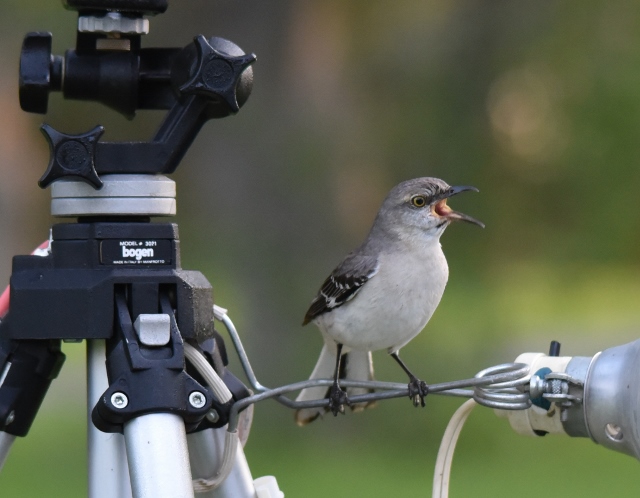A friend called and said, “It’s spring, why don’t you write about the mockingbird? Why do they sing all night long?”

So, don’t you know, Lionel Richie’s 1983 hit single, “All Night Long,” has been going through my head — especially the last couple of days while I’ve been photographing everything moving, chirping or blooming for the City Nature Challenge.
The mockingbirds in our yard have really ramped up their antics. They’re up really early — usually sitting on or under the security lights catching bugs. They’re braver. They chase larger birds, like grackles, through the air — away from their nests. They get closer to humans in spring, my husband mentioned the other day.
The long and short of it is, of course, it’s spring. It’s the mating season.
All adult male mockingbirds sing during the day. It’s only the bachelors that sing at night.
Yes, they might sing all night long. The night music is a love song, according to Birdwatching.com.
Once the male birds find a mate, the singing will usually stop as they begin the process of nest building and raising young. (wild-bird-watching.com). If a male fails to find a mate he will sing loudly until late in the season. If no mate is found he will abandon his territory.
Mockingbird mating season is April to July, and sometimes longer. Males generally establish a nesting territory as early as February.
From all those serenading male mockingbirds, females will eventually select a mate or reunite with a male from the previous season. Once a pair bond is established, the songs are shortened and more subdued. Sitting together quietly both mockingbirds make a “hew-hew” call to keep in contact. (Gardening-for-wildlife.com)
Most songbirds learn all the songs they’ll ever sing before they’re a year old. But the mockingbird continues to expand his collection throughout his life. (birdwatching.com)
With the ability to learn nearly 200 different songs, Northern Mockingbirds are veritable avian jukeboxes, according to abcbirds.org. “These expert mimics find inspiration in the songs of other birds and sometimes rock their tunes around the clock. This happens most often when males are searching for mates, but full moons also get these crooners going.
“They belt out their songs as loudly as possible in all directions and they prefer to do it at the most aggravating time for humans — midnight to 4 a.m. Studies have shown they sing more on moonlit nights and in well-lit areas. Woe to city and suburban dwellers near street lights!”
The male and female mockingbirds both sing, according to sciencing.com. “The males, however, boast a far greater range of vocalization and frequency of song. Males mimic the songs of other birds, frogs, dogs, sirens and even alarm clocks. They sing different sets of songs, one for spring and one for autumn. The males increase their singing for spring breeding season. Their impressive vocal roster serves the purpose of attracting a female for breeding, and also for defending their territory.
“Females prefer males with a more varied set of songs, which signals experience and an established territory. Unmated males burst into song at all hours seeking a mate, even at night. Females do not sing often during breeding season. Females do sing in autumn. Scientists think the males’ singing resets the female’s reproductive system.” (sciencing.com)
Research has shown that mockingbird males, like songbirds everywhere, sing to attract mates and to advertise territorial boundaries during the day, according to animal-diversity.org.
Related to the catbird and thrasher, the name mockingbird means “mimic of many tongues;” mockingbirds are able to imitate more than 30 bird songs in succession. Other sounds such as squeaky hinges, barking dogs, chirping crickets and even your alarm clock, are also imitated.
The male mockingbird learns the songs of other birds and incorporates them into his own songs. Mockingbirds also sometimes “sing” the sounds of people whistling, frogs croaking, and doorbells ringing, according to birdwatching.com
Mockingbirds are strongly monogamous.
One unique habit of mockingbirds is that they defend two separate territories. One is the breeding territory, the other is their fall and winter feeding territory, both are about one to two acres in size, although the feeding territory is generally smaller.
Now that you know all about their vocalizations, here’s some habitat information that will keep them around your yard: Mockingbirds forage for insects — beetles, ants, spiders and moths — and fruits — they especially enjoy figs. They also eat harmful weevils, cucumber beetles, chinch bugs and grasshoppers.
Texas and 6 other states claim the mocking bird as their state bird. Songs, poems and entire books have been written about the mockingbird.
Here’s my tribute to the mockingbird, in the form of a limerick:
“The Mockingbird Sings”

There once was a bird who came knocking At the shop door where I was working He said to me fool Shut off that loud tool It's the radio tune I am mocking
Limericks are fun five-line poems with a distinctive rhythm. The first, second and fifth lines contain 7 to 10 syllables and rhyme. The third and fourth lines have 5 to 7 syllables and rhyme with each other. Limericks are silly; they’re written to elicit a laugh or an eye-rolling groan. They have to rhyme and make some sort of sense. You can’t make up words to make them rhyme.
Try your hand at a fun limerick — about anything — and tell us about it!

Leave a Reply